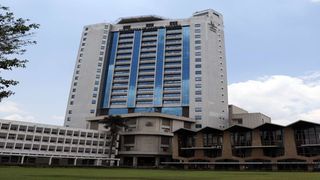
A section of the University of Nairobi in this picture taken on October 01, 2020.
| Dennis Onsongo | Nation Media GroupNews
Premium
Broke public universities lose Sh9bn in budget cuts
What you need to know:
- The Treasury has allocated university education Sh99.9 billion, down from the Sh109.3 billion in the current financial year.
- The University of Nairobi (UoN), Kenyatta and Moi universities are among select State-owned agencies lined up for IMF-backed structural reforms.
The financial crisis facing public universities is set to deepen after the National Treasury cut funding by 9 percent- Sh9.4billion- despite an expected increase in enrolment.
In the 2021/22 budget, the Treasury has allocated university education Sh99.9 billion, down from the Sh109.3 billion in the current financial year.
This means that public universities, which are now facing structural reforms sponsored by the International Monetary Fund (IMF), should brace themselves for a tougher year ahead.
Universities will this year admit an extra 17, 393 students as more candidates in the 2020 Kenya Certificate of Secondary Education (KCSE) exam qualified for admission compared to 2019.
Some 143,140 candidates scored C+ and above making them eligible for admission to government-sponsored programmes.
“The State Department experienced challenges including financial constraints to Public Universities as total resources allocated to Universities only covered 57 percent as opposed to the 80 percent Differentiated Unit Cost (DUC) required as capitation,” the budget document reads in part.
The University of Nairobi (UoN), Kenyatta and Moi universities are among select State-owned agencies lined up for IMF-backed structural reforms that are set to cost thousands of jobs and overhaul management of these institutions.
Inadequate funding
Recent audit reports show that the three universities have a combined workforce of over 12,000 employees, both academic and non-teaching staff, who gobble up billions of shillings in yearly wages.
UoN has the largest wage bill spending about Sh8.7 billion on personal emoluments, followed by KU (Sh5.6 billion) and Moi University at Sh4.69 billion.
As budgets are squeezed, the number of students joining public universities has been on a steady increase in the last three years.
The economic survey shows that by the end of 2019, there were 509,473 students in all universities and the annual enrolment has grown from 68,550 in 2018 to 89,488 in 2019.
In the new financial year, the UoN is expected to have the highest enrolment at 36,553 learners followed by Kenyatta (34397), Jomo Kenyatta University of Agriculture and Technology (29197) and Moi University (28406) among others. The government will also sponsor a total of 71,242 students in private universities.
The budget document adds that other challenges facing university education include inadequate funding for the Higher Education Loans Board (Helb) as the average loan per student is presently at Sh40,000 instead of the recommended Sh70,000 in an academic year.
The number of students receiving university loans through Helb increased from 233,444 in 2019 to 243,084 by the end of 2020.
New budget
The emergence of the Covid -19 pandemic has also added to the problems facing public universities since it has led to a sharp decline in Appropriations in Aid (AIA) generated by Universities due to long closure of Universities in 2019/2020, increasing their overreliance on the exchequer. The health crisis has also cut funding for research, which offers public universities additional sources of income.
Despite the budget cuts to universities, the education sector will receive the biggest chunk of the Sh3.6 trillion budget in the new financial year that starts in July.
To keep learners in school, pay tutors and keep the sector from kindergarten to universities running, the Treasury has set aside Sh509.2 billion.
More than half of this amount, or 55 percent of this allocation, will go to the Teachers Service Commission (TSC). The bulk of this amount will pay salaries for 339,060 teachers in primary and secondary schools.
There is however no allocation for hiring additional teachers in primary schools. This means that primary schools will have to do with 2000 intern teachers to be recruited in the year.
Secondary schools will have better luck in the new budget since TSC will hire 3500 additional teachers for secondary schools in addition to 5000 intern teachers that will be recruited.
Increased expenditure
The tertiary education budget cuts will also affect Vocational and Technical Training, which will see their budgets shrink by 6 percent to Sh23.2 billion. Early leaning and basic education department will be a key beneficiary of the budget kits after its budgets was increased by 5 percent to Sh103.9 billion. Treasury has also doubled the budget for the post training and skills development department to Sh268 million in the new financial year.
Education has remained one of the big priorities for the Jubilee administration, receiving generous allocations over the years. But the bulk of the increased expenditure has always been channeled to the TSC, which is the fulcrum of the sector.
The approved budget of the TSC has increased from Sh218.3 billion in 2017/2018 to Sh241.1 billion in 2018/2019 and Sh256.1 billion in the 2019/2020 fiscal year.
But the actual expenditure for the period was Sh217.6 billion, Sh240.8 billion and Sh255.8 billion for 2017/2018, 2018/2019 and 2019/2020 financial years respectively.
Compensation to employees contributed to 99.4 percent of the total budget of the Commission. In the last three years, the Commission recruited 19,700 teachers.
The death of parallel degree programs have seen public universities register persistent losses for an extended period.





